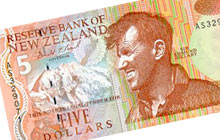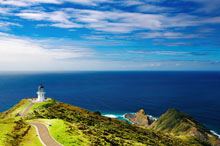
Travel Info
Language
English is the predominant language in New Zealand, spoken by 98 percent of the population. Some particularities build the New Zealand English dialect, in which we can highlight the pronunciation of words such as "bad", "dead", "fish" and "chips" sound like "bed", "did", "fush" and "chups" to non-New Zealanders.
In the 2000s New Zealand English varieties included Māori English, which was mostly, but not exclusively, spoken by Māori; and Southland English, which features what people call a rolling ‘R’.
In the past people complained that the New Zealand accent was due to laziness or bad influences. Today it is thought to be based on the accent of south-east England, where most migrants came from.
Currency
 The official New Zealand currency is the New Zealand Dollar,
whose symbol is NZ$.
The official New Zealand currency is the New Zealand Dollar,
whose symbol is NZ$.
As at October 2014 the currency exchange rate is as below.
To get the accurate currency rate exchange of the day click here
Weather
New Zealand's climate is complex due to its highly varied topography and varies from warm subtropical in the far north to cool temperate climates in the far south, with severe alpine conditions in the mountainous areas (around -10°C).
 As most of the country lies close to the coast, the
temperatures are mild during whole year, that means generally
there are relatively small variations between summer and winter
temperatures, although inland and to the east of the ranges the
variation is greater (up to 14°C).
As most of the country lies close to the coast, the
temperatures are mild during whole year, that means generally
there are relatively small variations between summer and winter
temperatures, although inland and to the east of the ranges the
variation is greater (up to 14°C).
January and February are the warmest months, and July is the coldest month of the year with snow in the south and rain in the north. During springer the weather is unpredictable from cold, frosty, clear days to sunny and hot. Temperatures during autumn are a little cooler than summer but the New Zealand weather can be excellent. In summer, the average maximum temperature ranges between 20-30°C and in winter between 10-15°C.
The midday summer solar radiation index (UVI) is often very high in most places and can be extreme in northern New Zealand and in mountainous areas. Autumn and spring UVI values can be high in most areas. Due that, the sunlight can quickly burn skin even on cloudy days. So, it is highly recommended the use of SPF 30+ sunscreen and wearing a shirt, hat and sunglasses.
Click here to see what the weather looks like in New Zealand right now!
Time
New Zealand Standard Time (NZST) is 12 hours ahead of Greenwich Mean Time (GMT). During summer daylight saving time is observed since the last Sunday in September until the first Sunday of the following April, and NZDT is used instead (GMT+13).
Travel Distances
Due to the short distances amongst its cities, tourists can easily travel around New Zealand. As a small country, hiring a car and driving from one place to the other is common, however it is recommendable to travel by plane if you are planning on travelling from the North to the South Island or from cities located on the extremes in each island. Check below the travel distances in Kilometres.
North Island Travelling Distances (Distance in Km)
| Cities | Auckland | Cape Reinga | Coromandel | Hamilton | New Plymouth | Paihia | Palmerston North | Rotorua | Taupo | Wellington | Whangarei |
|---|---|---|---|---|---|---|---|---|---|---|---|
| Auckland | 441 | 157 | 112 | 349 | 247 | 515 | 219 | 264 | 634 | 178 | |
| Cape Reinga | 441 | 589 | 567 | 781 | 213 | 947 | 651 | 696 | 1,066 | 264 | |
| Coromandel | 157 | 589 | 163 | 392 | 395 | 514 | 214 | 263 | 633 | 326 | |
| Hamilton | 117 | 544 | 163 | 240 | 350 | 404 | 108 | 153 | 523 | 281 | |
| New Plymouth | 353 | 781 | 391 | 239 | 587 | 234 | 297 | 295 | 353 | 518 | |
| Paihia | 247 | 213 | 396 | 351 | 588 | 753 | 458 | 502 | 873 | 70.3 | |
| Palmerston North | 520 | 947 | 514 | 403 | 234 | 753 | 332 | 252 | 141 | 684 | |
| Rotorua | 224 | 651 | 214 | 108 | 297 | 457 | 332 | 81.3 | 452 | 388 | |
| Taupo | 269 | 696 | 263 | 152 | 296 | 502 | 251 | 81.3 | 371 | 433 | |
| Wellington | 639 | 1,066 | 633 | 522 | 353 | 872 | 140 | 451 | 371 | 803 | |
| Whangarei | 178 | 264 | 326 | 282 | 519 | 70.2 | 684 | 388 | 433 | 803 |
South Island Travelling Distances (Distance in Km)
| Cities | Christchurch | Dunedin | Franz Josef | Hanmer Springs | Invercargill | Milford Sound | Mt Cook | Nelson | Queenstown |
|---|---|---|---|---|---|---|---|---|---|
| Christchurch | 361 | 386 | 134 | 567 | 758 | 330 | 415 | 483 | |
| Dunedin | 361 | 555 | 487 | 206 | 407 | 320 | 769 | 283 | |
| Franz Josef | 386 | 555 | 387 | 524 | 625 | 484 | 459 | 350 | |
| Hanmer Springs | 134 | 487 | 387 | 693 | 883 | 456 | 300 | 609 | |
| Invercargill | 568 | 206 | 524 | 693 | 273 | 435 | 975 | 186 | |
| Milford Sound | 758 | 407 | 625 | 883 | 273 | 537 | 1,165 | 288 | |
| Mt Cook | 330 | 320 | 484 | 456 | 435 | 537 | 737 | 262 | |
| Nelson | 415 | 769 | 459 | 300 | 975 | 1,165 | 737 | 890 | |
| Queenstown | 483 | 283 | 350 | 609 | 186 | 288 | 262 | 890 |
Visa
On arrival, New Zealand’s visitors need to present to Immigration a passport that is valid for at least three months beyond the intended departure date. People from visa-waiver countries can spend for up to three months in New Zealand and do not need to apply for a visa before their arrival, but they need to provide travel tickets or evidence of onward travel arrangements and evidence of funds for maintenance.
UK passport holders are granted a visitor visa for up to 6 months upon arrival in New Zealand. Australian citizens and permanent residents do not usually need a visa to travel to New Zealand.
Travel Insurance
Even with the best planned holidays, the unexpected can happen. Travel insurance is just as important as your airfares and accommodation. Our dedicated partner Comprehensive Insurance offers a complete range of solutions to insure your travel for both Leisure & Business travelers.
Comprehensive:
Simply the top of the range product for all travelers. This
policy includes higher limits and extended benefits including
cover for terrorism and civil unrest.
Get an instant quote
Essentials:
A policy ideally suited for the cost conscious traveler who
only requires a basic level of benefits.
Get an instant quote
Business:
Cover designed exclusively for the specific requirements of
the business traveler which includes cover for trade samples and
business equipment.
Get an instant quote
* Comprehensive Travel Insurance is underwritten by Allianz Australia Insurance Limited.
